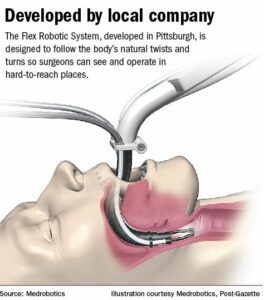 James Jordan half-jokingly said he thought he “might be investing in a sock puppet.”
James Jordan half-jokingly said he thought he “might be investing in a sock puppet.”
The year was 2005. Mr. Jordan, one of four executives-in-residence at the Pittsburgh Life Sciences Greenhouse on the South Side at the time, had just volunteered to help Howie Choset, a Carnegie Mellon University robotics professor, and Marco Zenati, then a cardiac surgeon at the University of Pittsburgh, develop and market a “snake robot” device for use in minimally-invasive surgeries.
To demonstrate their project, they had brought a contraption of links held together with wire and operated in a marionette fashion.
Mr. Jordan’s colleagues were skeptical: The market already had a robotic surgical tool, they said, the now-widely used Da Vinci Surgical System. The new project seemed too major an investment and would take too long to get to market, the ultimate goal for Greenhouse incubator projects.
But Mr. Jordan, now vice president and chief investment officer at the Greenhouse, saw the promise of a surgical tool that could be navigated through a small incision, moving around corners and behind organs to remove a tumor. Unlike the sometimes extensive disfigurement of traditional open surgery, this could minimize the physical trauma, speed up a patient’s recovery and leave minimal scarring.
The process of converting the snake robot model into a market-ready product was not easy or quick. Four years later, they had the first prototype ready for use on humans. The following year, 2010, the first clinical studies began in the Czech Republic and last summer, the U.S. Food and Drug Administration gave approval for its use for head and neck procedures.
By then, the device had been refined into something of an engineering marvel: a one-armed articulated robot equipped with a camera that allows the surgeon to see and reach tumors in tight places.
“This is something that could have only been done in Pittsburgh,” said Mr. Choset. “There is nowhere else in the world that has the medical expertise and robotics expertise, and an interest in economic development in the life sciences. All three of those are critical.”
After several name changes (“People don’t like thinking there’s a snake in their body,” said Mr. Choset), the Flex Robotic System is now the centerpiece of a $130 million privately-held Medrobotics based in Massachusetts which, a decade ago and before Google and Uber’s arrival in Pittsburgh, was a hotbed for medical device and robotic product development.
The system is also the new darling in the world of robotics medicine.
Read More – Source: A flexible robot, developed in Pittsburgh, holds promise of saving lives | Pittsburgh Post-Gazette
Steve Twedt: stwedt@post-gazette.com or 412-263-1963.